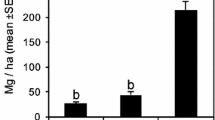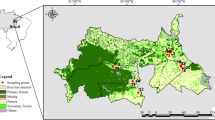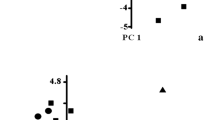Abstract
In the Mediterranean Basin, most cultivated areas were abandoned in the last century and are now in various stages of old-field succession. The aim of this work was to analyse the successional trajectories of these ecosystems, and to assess possible deviations in these pathways due to fire occurrence at high or low recurrence levels. Old-fields abandoned either about 50 or about 100 years ago were selected in SE Spain. Within the 50-year-old abandoned fields, plots were established which had been burned by 1, 2 and 3 fires in the last 25 years. Cover values of vascular species were sampled and then analysed by means of multivariate analysis. Euclidean distances between resulting communities were used as an indicator of the possible deviation from the unburned successional pathway. Our results pointed to the possibility that different successional pathways may exist depending on fire occurrence and recurrence. In the absence of fire, the vegetation is dominated by pioneer species, mainly Pinus. With the passage of time this vegetation will become dominated by later successional tree species (Quercus). However, when early-successional communities are affected by fire, the succession can be diverted. A single fire is enough to change Pinus forests into alternative stable states dominated by Rosmarinus officinalis shrub communities, where the colonisation of species in later successional stages is arrested. This deviation increases in high fire recurrence regimes where the vegetation changes to dwarf shrubs and herbs.



Similar content being viewed by others
References
Acacio V, Holmgren M, Jansen P, Schrotter O (2007) Multiple recruitment limitation causes arrested succession in Mediterranean oak systems. Ecosystems 10:1220–1230
Baeza MJ, De Luís M, Raventós J, Escarré A (2002) Factors influencing fire behaviour in shrublands of different stand ages and the implications for using prescribed burning to reduce wildfire risk. J Environ Manage 65:199–208
Baeza MJ, Valdecantos A, Alloza JA, Vallejo VR (2007) Human disturbance and environmental factors as drivers of long-term post-fire regeneration patterns in Mediterranean forests. J Veg Sci 18:243–252
Barberó M, Loisel R, Quézel P (1992) Biogeography, ecology and history of Mediterranean Quercus ilex ecosystems. Vegetatio 99–100:19–34
Blondel J, Aronson J (1999) Biology and Wildlife of the Mediterranean Region. Oxford University Press, New York
Bolòs O, Vigo J, Masalles RM, Ninot JM (1993) Flora Manual dels Països Catalans. Pòrtic, Barcelona
Bonet A, Pausas JG (2004) Species richness and cover along a 60-year chronosequence in old-fields of southeastern Spain. Plant Ecol 174:257–270
Bonet A, Pausas JG (2007) Old field dynamics on the dry side of the Mediterranean Basin: patterns and processes in semiarid Southeast Spain. In: Cramer VA, Hobbs RJ (eds) Old fields: dynamics and restoration of abandoned farmland. Island press, Washington, pp 247–264
Capitanio R, Carcaillet C (2008) Post-fire Mediterranean vegetation dynamics and diversity: a discussion of succession models. For Ecol Manage 255:431–439
Connell JH, Slatyer RO (1977) Mechanisms of succession in natural communities and their role in community stability and organization. Am Nat 111:1119–1144
Cramer VA, Hobbs RJ, Standish RJ (2008) What’s new about old fields? Land abandonment and ecosystem assembly. Trends Ecol Evol 23:104–112
Debussche M, Escarré J, Lepart J (1982) Ornitichory and plant succession in Mediterranean orchards. Vegetatio 48:255–266
Debussche M, Escarré J, Lepart J, Houssard C, Lavorel S (1996) Changes in Mediterranean plant succession: old-fields revisited. J Veg Sci 7:519–526
Donato DC, Fontaine JB, Robinson WD, Kauffman JB, Law BE (2009) Vegetation response to a short interval between high-severity wildfires in a mixed-evergreen forest. J Ecol 97:142–154
Eugenio M, Lloret F (2004) Fire recurrence effects on the structure and composition on Mediterranean Pinus halepensis communities in Catalonia (northeast Iberian Peninsula). Ecoscience 11:446–454
Eugenio M, Lloret F (2006) Effects of repeated burning on Mediterranean communities of the northeastern Iberian Peninsula. J Veg Sci 7:755–764
Eugenio M, Verkaik I, Lloret F, Espelta JM (2006) Recruitment and growth decline in Pinus halepensis populations after recurrent wildfires in Catalonia (NE Iberian Peninsula). For Ecol Manage 231:47–54
Fox MD, Fox BJ (1987) The role of fire in scleromorphic forests and shrublands of Eastern Australia. In: Trabaud L (ed) The role of fire in ecological systems. SPB, the Hague, pp 23–48
Friedel MH (1991) Range condition assessment and the concept of thresholds: a viewpoint. J Range Manage 44:422–426
Gómez JM (2004) Importance of microhabitat and acorn burial on Quercus ilex early recruitment: non-additive effects on multiple demographic processes. Plant Ecol 172:287–297
Greig-Smith P (1983) Quantitative Plant Ecology. Blackwell, Oxford
Grubb PJ (1998) A reassessment of the strategies of plants which cope with shortages of resources. Perspect Plant Ecol Evol Syst 1:3–31
Haidinger TL, Keeley JE (1993) Role of high fire frequency in destruction of mixed chaparral. Madroño 40:141–147
Hanes TL (1971) Succession after fire in the chaparral of Southern California. Ecol Monogr 41:27–52
Johnstone J, Chapin F (2006) Fire interval effects on successional trajectory in boreal forests of Northwest Canada. Ecosystems 9:268–277
Keeley JE, Fotheringham CJ, Baer-Keeley M (2005) Determinants of postfire recovery and succession in Mediterranean-climate shrublands of California. Ecol Appl 15:1515–1534
Laycock WA (1991) Stable states and thresholds of range conditions on North American rangelands: a view point. J Range Manage 44:427–433
Lloret F, Vilà M (2003) Diversity patterns of plant functional types in relation to fire regime and previous land use in Mediterranean woodlands. J Veg Sci 14:387–398
Lloret F, Pausas JG, Vilà M (2003) Responses of Mediterranean plant species to different fire frequencies in Garraf Natural Park (Catalonia, Spain): field observations and modelling predictions. Plant Ecol 167:213–225
Lookingbill TR, Zavala MA (2000) Spatial pattern of Quercus ilex and Quercus pubescens recruitment in Pinus halepensis dominated woodlands. J Veg Sci 11:607–612
Manly BFJ (1986) Multivariate Statistical Methods. Chapman and Hall, London
McCune B (2007) Improved estimates of incident radiation and heat load using non-parametric regression against topographic variables. J Veg Sci 18:751–754
Milligan AL, Putwain PD, Cox ES, Ghorbani J, Le Duc MG, Marrs RH (2004) Developing an integrated land management strategy for the restoration of moorland vegetation on Molinia caerulea-dominated vegetation for conservation purposes in upland Britain. Biol Conserv 119:371–387
Mitchell RJ, Auld MHD, Le Duc MG, Marrs RH (2000) Ecosystem stability and resilience: a review of their relevance for the conservation management of lowland heaths. Perspec Plant Ecol Evol Syst 3:142–160
Nathan R, Safriel UN, Noy-Meir I, Schiller G (2000) Spatiotemporal variation in seed dispersal and recruitment near and far from Pinus halepensis trees. Ecology 81:2156–2169
Ne’eman G, Izhaki I (1996) Colonization in an abandoned East-Mediterranean vineyard. J Veg Sci 7:465–472
Noble I, Slatyer RO (1980) The use of vital attributes to predict successional changes in plant communities subject to recurrent disturbances. Vegetatio 43:5–21
Oksanen J, Kindt R, Legendre P, O’Hara B, Henry M, Stevens H (2007) Vegan: Community Ecology Package. R package version 1.8-7. http://cran.r-project.org, http://cc.oulu.fi/fi/~jarioksa/. Accessed 12 September 2007
Pausas JG (2004) Changes in fire and climate in the eastern Iberian Peninsula (Mediterranean Basin). Clim Change 63:337–350
Pausas JG, Ribeiro E, Vallejo VR (2004) Post-fire regeneration variability of Pinus halepensis in the eastern Iberian Peninsula. For Ecol Manage 203:251–259
Picket STA, Collins SL, Armesto JJ (1987) A hierarchical consideration of causes and mechanisms of succession. Vegetatio 69:109–114
Platt WJ, Connell JH (2003) Natural disturbances and directional replacement of species. Ecol Monogr 73:507–522
Pons X, Pausas JG (2006) Oak regeneration in heterogeneous landscapes: the case of fragmented Quercus suber forests in the eastern Iberian peninsula. For Ecol Manage 231:196–204
Pons X, Pausas JG (2007) Acorn dispersal estimated by radio-tracking. Oecologia 153:903–911
Putz FE, Canham CD (1992) Mechanisms of arrested succession in shrublands: root and shoot competition between shrubs and tree seedlings. For Ecol Manage 49:267–275
Quézel P (2004) Large-scale post-glacial distribution of vegetation structure in the Mediterranean region. In: Mazzoleni S, Di Pasquale G, Mulligan M, Di Martino P, Rego F (eds) Recent dynamics of the Mediterranean vegetation and landscape. J. Wiley & Sons, Chichester, pp 3–12
Raunkiaer C (1934) The life form of plants and statistical plant geography. Clarendon Press, Oxford
Scheffer M, Carpenter S, Foley JA, Folke C, Walker B (2001) Catastrophic shifts in ecosystems. Nature 413:591–596
Siles G, Rey PJ, Alcántara JM, Ramírez JM (2008) Assessing the long-term contribution of nurse plants to restoration of Mediterranean forests through Markovian models. J Appl Ecol 45:1790–1798
Tatoni T, Roche P (1994) Comparison of old-field and forest revegetation dynamics in Provence. J Veg Sci 5:295–302
R Development Core Team (2007) R: a language and environment for statistical computing. R Foundation for Statistical Computing, Vienna, Austria. ISBN 3-900051-07-0. http://www.R-project.org. Accessed 12 September 2007
Ter Braak CJF, Smilauer P (1998) CANOCO reference manual user’s guide to Canoco for Windows: Software for Canonical community ordination (version 4.5). Micro-computer Power, Ithaca, New York
Trabaud L (1991) Fire regimes and phytomass growth dynamics in a Quercus coccifera garrigue. J Veg Sci 2:307–314
Vega JA (2003) Regeneración del género Pinus tras incendios. Cuadernos Sociedad Española de Ciencias Forestales 15:59–68
Verdú M (2000) Ecological and evolutionary differences between Mediterranean seeders and resprouters. J Veg Sci 11:265–268
Verdú M, García-Fayos P (1998) Old-field colonization by Daphne gnidium: seedling distribution and spatial dependence at different scales. J Veg Sci 9:713–718
Zar JH (1996) Biostatistical analysis. Prentice May, Upper Saddle River, New Jersey
Zavala MA (2003) Dinámica y sucesión en bosques mediterráneos: modelos teóricos e implicaciones para la selvicultura. In: Rey-Benayas JM, Espigares T, Nicolau JM (eds) Restauración de ecosistemas mediterráneos. Universidad de Alcalá, Madrid, pp 43–63
Zavala MA, Espelta JM, Retana J (2000) Constraints and trade-offs in Mediterranean plant communities: the case of holm oak-Aleppo pine forests. Bot Rev 66:119–149
Zedler PH, Gautier CR, McMaster GS (1983) Vegetation change in response to extreme events: the effect of a short interval between fires in California chaparral and coastal scrub. Ecology 64:809–818
Acknowledgements
We thank J. Scheiding for revision of the English text and the Font Roja Natura-UA Scientific Station for fieldwork support. We also thank the two referees whose suggestions greatly improved the previous drafts of this study. V.M. Santana was supported by a FPU grant awarded by the Spanish Ministry of Education and Science. This research was carried out within the FIREMED (AGL200/8-04522/FOR) and Consolider-Ingenio 2010 (GRACCIE CSD2007-00067) projects. CEAM is supported by the Generalitat Valenciana and Bancaixa.
Author information
Authors and Affiliations
Corresponding author
Rights and permissions
About this article
Cite this article
Santana, V.M., Jaime Baeza, M., Marrs, R.H. et al. Old-field secondary succession in SE Spain: can fire divert it?. Plant Ecol 211, 337–349 (2010). https://doi.org/10.1007/s11258-010-9793-y
Received:
Accepted:
Published:
Issue Date:
DOI: https://doi.org/10.1007/s11258-010-9793-y




